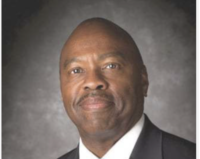Q&A With LA Metro's Phil Washington

LA Metro plans billions in ambitious rail extensions.
ENR interviewed Phillip A. Washington, CEO with LA Metro, for the February cover story on mass transit trends. Below are additional excerpts, condensed and edited, from the interview.
What factors went into the successful ballot measure that will pump $120 billion more over the next 40 years for LA projects?
First of all, a key part of this success was the bottoms-up approach. It was this idea of going out to the nine sub-regions in the county, the Councils of Governments, and asking them to identify and prioritize their own projects instead of us just coming up with proposed projects. That was a huge key to the success. We put together performance metrics and evaluation criteria to evaluate the projects that we received from them. Then we evaluated those projects individually and as part of the whole system. That led to our sequencing of the projects. Another key was that we embedded local returns in our program. There are 88 cities in this county – talk about trying to get the cities to have stakes in all of this! That local return component is so cities can fix local streets and potholes and sidewalks.
Can you explain this local returns thing a bit more?
For example, we now have $120 billion over 40 years. Of that, $23 billion goes back to the cities—about 17%. The diverse coalition of support around the county was key. I’d point to bold leadership both on board of directors and staff. We’re still writing the guidelines for how to administer all of this. But the key was making it flexible.
How did the city rebound from a failed 2012 measure to extend Measure R in 2008?
I’d point against to the courageous political leadership in LA.
What about the office you created at LA Metro—the Office of Extraordinary Innovation?
We have asked them to research innovation from all over the world and look to implement it. We have an unsolicited proposal policy, looking to accelerate projects all over the county. They are providing various ideas – operational things. For instance, we want to start our own Uber-like service—smaller vehicles and our own drivers for that first and last mile [to transit facilities].
We just had a meeting where we are looking to move unsolicited proposals forward. For example, the Sepulveda Pass [expansion], which is probably worst stretch of road in the country, we’re looking to accelerate by 10-15 years. We’ve put in Measure M some exploratory projects with seed money of $500,000 a year. We have nine unsolicited proposals now. There are really cool ideas like an express train from Union Station to LAX.
What about plans for revamping Union Station?
We want to create a destination around Union Station. One of the things we’re looking at is the possibility of creating a Tax Incremental Financing District, similar to what we did for the Denver station. We capture some of the value from the real estate built around or in the district. So we have talked to the city council. What we want to do is create the district, build out the station to accommodate both us and high-speed rail, and have retail, residential, office space. We envision the station to be a huge destination, not just for traveling through.
What lessons learned will be brought from the successful Denver Union Station job?
Two loans were used in Denver—TIFIA and RRIF (Railroad Rehabilitation & Improvement Financing) loans. They are being paid back at accelerated rates. Before I left [to come to LA Metro], we thought that it would take the first 10 years to start paying down the loan. Right now with the rate of real estate that taken hold, they are seven years ahead of schedule. When the station reopened in 2014, we anticipated $600 million in real estate revenue. It’s been over a $1 billion.
Now we’re looking to do something similar [in LA]. It will be a little more challenging here because we have a big county jail next door. Also, we need money from [the California High-Speed Rail Authority]. In order to renovate the station to accommodate HSR, we need $1 billion. Also, we keep saying to the feds they have to make RRIF loans easier to navigate. We hope this administration does that. There is $35 billion in RIFF funds but they are used on so few projects, because it’s so daunting to get through the application process.
How about the planned transit connections to LAX?
We are in total partnership with LAX. We just took to our board this month some work that will allow us to build the [airport] station sooner than what we’d planned. It will be ready prior to the Olympics. So will the Crenshaw Line that will feed into the station. It’s about 8.5 miles of light rail that will finish in 2019. The airport is building a people mover to come out to our station. We’re accelerating the projects that go to the potential venues, such as the Purple Line to UCLA.
For example, the West Side subway, we already have a portion of it operating. We’re building another nine miles of that subway in three phases. The first four-mile section is underway now, about 30%. We’ve awarded a design-build contract for the second 2.5-mile segment. The third 2.5 miles is going out for RQIs already. The subway tunnel is being built east to west in section 2. For section three we want to tunnel west to east, and meet in the middle [with section two]. We want to have a contest [to see who gets to the midpoint first].







